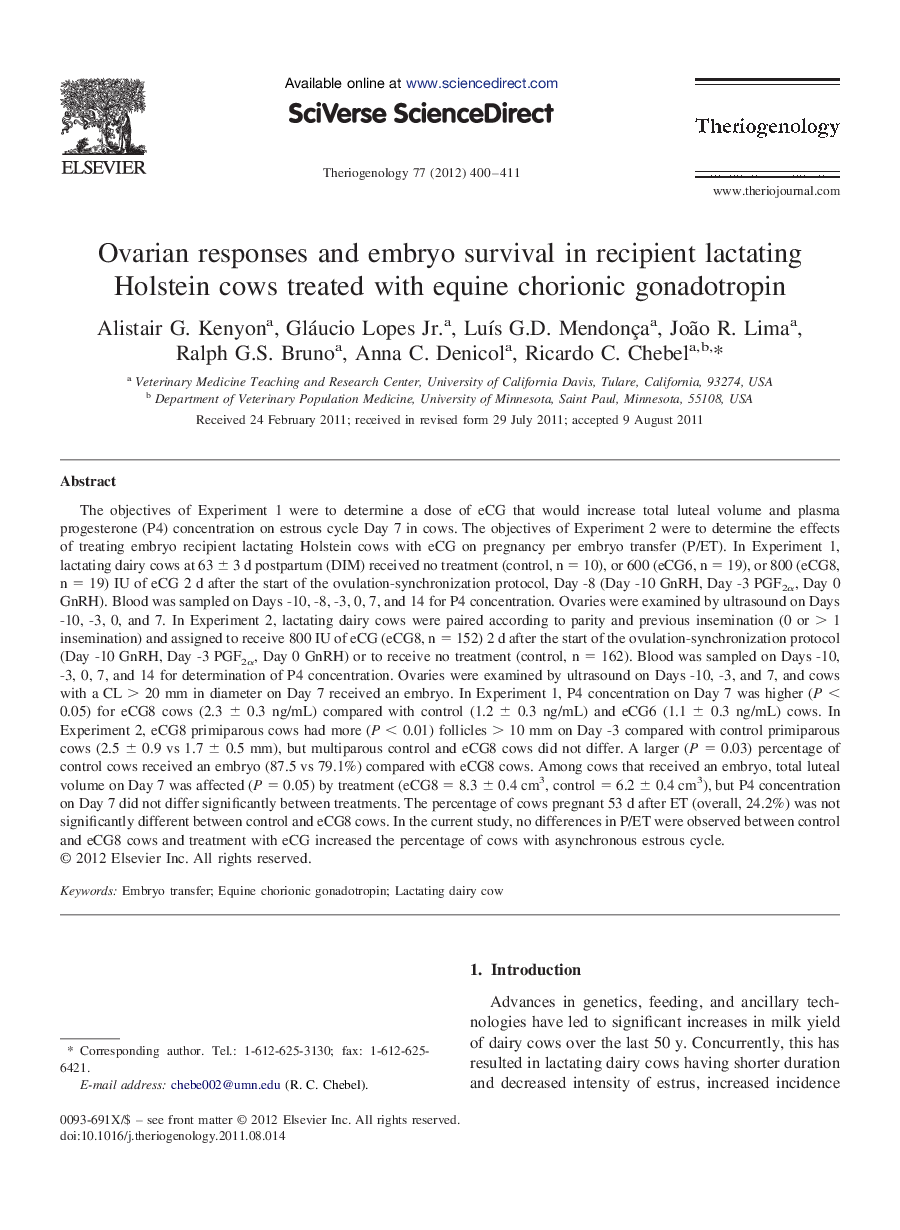| Article ID | Journal | Published Year | Pages | File Type |
|---|---|---|---|---|
| 2095346 | Theriogenology | 2012 | 12 Pages |
The objectives of Experiment 1 were to determine a dose of eCG that would increase total luteal volume and plasma progesterone (P4) concentration on estrous cycle Day 7 in cows. The objectives of Experiment 2 were to determine the effects of treating embryo recipient lactating Holstein cows with eCG on pregnancy per embryo transfer (P/ET). In Experiment 1, lactating dairy cows at 63 ± 3 d postpartum (DIM) received no treatment (control, n = 10), or 600 (eCG6, n = 19), or 800 (eCG8, n = 19) IU of eCG 2 d after the start of the ovulation-synchronization protocol, Day -8 (Day -10 GnRH, Day -3 PGF2α, Day 0 GnRH). Blood was sampled on Days -10, -8, -3, 0, 7, and 14 for P4 concentration. Ovaries were examined by ultrasound on Days -10, -3, 0, and 7. In Experiment 2, lactating dairy cows were paired according to parity and previous insemination (0 or > 1 insemination) and assigned to receive 800 IU of eCG (eCG8, n = 152) 2 d after the start of the ovulation-synchronization protocol (Day -10 GnRH, Day -3 PGF2α, Day 0 GnRH) or to receive no treatment (control, n = 162). Blood was sampled on Days -10, -3, 0, 7, and 14 for determination of P4 concentration. Ovaries were examined by ultrasound on Days -10, -3, and 7, and cows with a CL > 20 mm in diameter on Day 7 received an embryo. In Experiment 1, P4 concentration on Day 7 was higher (P < 0.05) for eCG8 cows (2.3 ± 0.3 ng/mL) compared with control (1.2 ± 0.3 ng/mL) and eCG6 (1.1 ± 0.3 ng/mL) cows. In Experiment 2, eCG8 primiparous cows had more (P < 0.01) follicles > 10 mm on Day -3 compared with control primiparous cows (2.5 ± 0.9 vs 1.7 ± 0.5 mm), but multiparous control and eCG8 cows did not differ. A larger (P = 0.03) percentage of control cows received an embryo (87.5 vs 79.1%) compared with eCG8 cows. Among cows that received an embryo, total luteal volume on Day 7 was affected (P = 0.05) by treatment (eCG8 = 8.3 ± 0.4 cm3, control = 6.2 ± 0.4 cm3), but P4 concentration on Day 7 did not differ significantly between treatments. The percentage of cows pregnant 53 d after ET (overall, 24.2%) was not significantly different between control and eCG8 cows. In the current study, no differences in P/ET were observed between control and eCG8 cows and treatment with eCG increased the percentage of cows with asynchronous estrous cycle.
